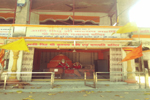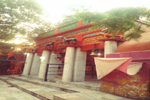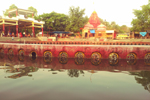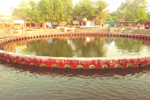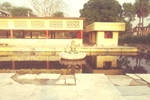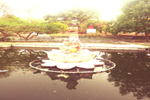Naimisharanya Chakra Teerth
Naimisharanya is the oldest teerth in India. It is supposed to be there since Satyug, the oldest era. In most of the ancient books including Bhagwat and Ramcharitmanas, Naimisharanya is mentioned. It is situated on the left bank of Gomati river in Sitapur district of Uttar Pradesh. From Lukcnow, Namishranya is about 90 km and can be reached easily by road.
From the most ancient times the spiritual energy of Naimish area has attracted saints, seers, rishis and scholars to practice their yog, dhyan, asceticism, penance and scholarly discussions here. Maharishi Vyas compiled Vedas here few thousands year ago and his residing place is marked here as Vyas-gaddi. You can also find places of Ma Anandmayi and Swami Nardanand from 20 th century here. Such is the constant flow of spiritual energy in this place.
The most prominent place of Naimish area is the Chakra Teerth. When rishis wanted to identify spots having dense divine energy appropriate for spiritual practice, they sought help of Lord Brahma who gave them a chakra (disc) and asked them to follow it. Ultimately the chakra descended into earth at Namisharanya and a strong gush of water appeared from that hole. To control that tremendous flow, the rishis again prayed to Brahma. He, in turn, sought the help of the Divine Mother who appeared there as Devi Lalita. The flow was controlled and hence that place is called Chakra Teerth.
Surrounding that pond was a dense forest or aranya of Neem trees, so the name is Naimisharanya. This forest also has a very important place in spiritual tradition. It is supposed to be one of the 8 main svayam vyakt Vishnu-Kshetrams of Alwar tradition which are spread all over India and Nepal. The other seven places are - Rangnath Swamy, Bhuvarah and Vanamamalai in Tamilnadu, Tirumala Venkateshwara in Andhra Pradesh, Pushkar in Rajasthan, Badrinath in Uttarakhand, and Shaligram or Muktinath in Nepal. The water body of Pushkar, Badri mountain of Badrinath and forest of Naimisharaanya are taken as forms of Vishnu in Alwar tradition. Also, it is said that Lord Vishnu and ancient rishis reside in this forest in the form of trees.
At walking distance from Chakra Teerth one can find the places where ancient rishis used to dwell. Those of Vyas, Manu and Satrupa etc are well identified. Adi Shankaracharya, great devotees and saints Vitthal and Surdas also spent time there. On the other side of Chakra Teerth is temple of Lalita Devi. Apart from the aforementioned story of Lalita Devi, it is also said that this temple is one of the Shakti Peethas. The heart of Goddess Sati fell here when Shiva was carrying her self-immolated body after destroying the yagya of Daksha.
About 2 km from here is Hanuman Garhi and the place where the Pandavas stayed during their exile. Story of the Hanuman temple here is interesting. When Hanuman defeated Ahiravana to rescue Lord Ram and Laxman in the underworld, he re-appeared at the surface here, with the two brothers seated on his shoulders. Another story says that Lord Ram organised an Ashwamedh yagya and eventually got to meet his sons Luv and Kush here.
Another important place in this area is the Dadhichi Kund. Here, Rishi Dadhichi sacrificed himself to let Indra use his bones to make weapons to destroy demons. Dadhichi is the personification of Indian socio-spiritual tradition that puts collective welfare over individual interest. When Dadhichi was preparing for sacrifice, he expressed his desire to take bath in different teerthas, so Indra invoked the various sacred rivers and water bodies in a pond that exists here till date. Interestingly, Dadhichi was the first rishi to leave the yagya of the powerful king Daksha when he came to know that Lord Shiva was not invited there.




